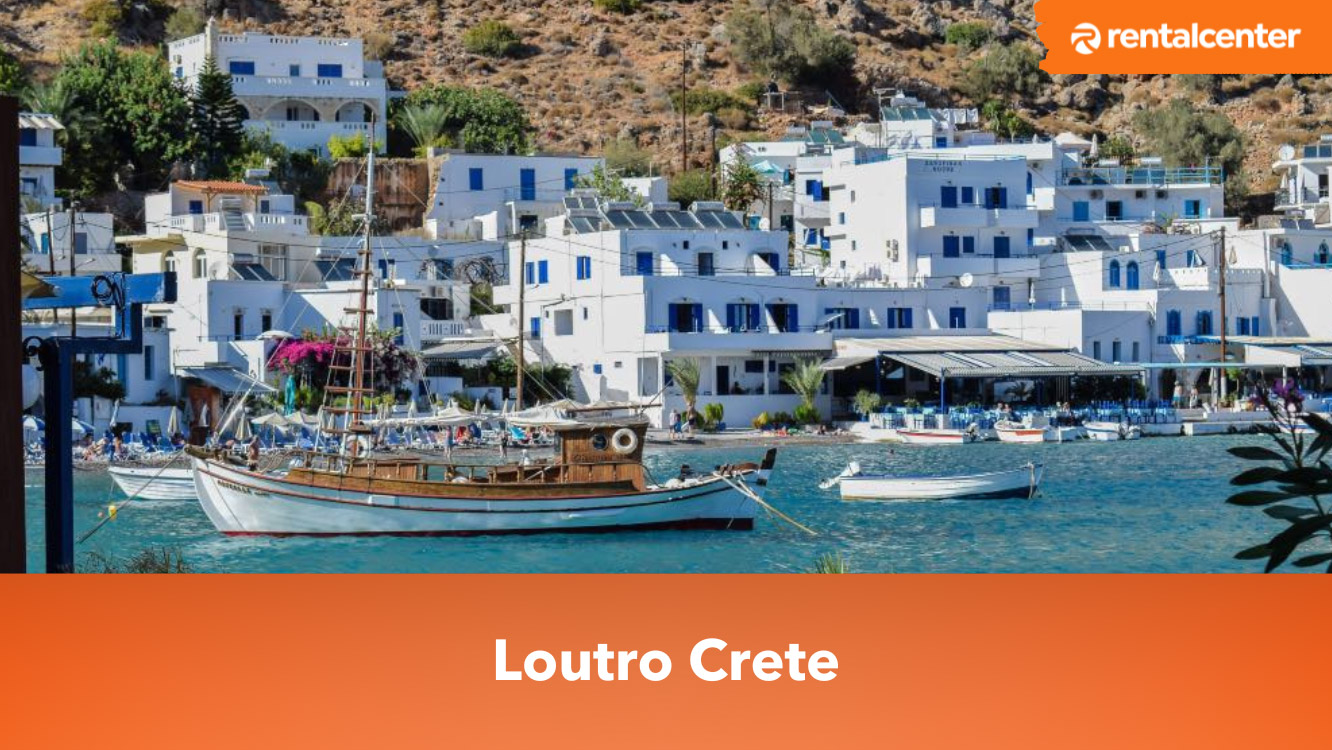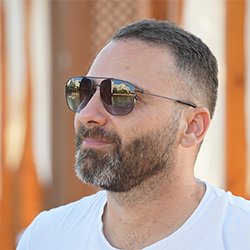Loutro is one of the prettiest villages to visit in Chania because of the iconic whitewashed villages. Loutro Crete is a perfect destination to experience different kinds of adventure and enjoy the attractions. It is a small, remote seaside village in southern Crete, located 96 kilometres from Chania. Loutro is about a 2-hours drive away from the main town of Chania. The name Loutro got its name from the Greek word “bath” because of the ancient baths in the area. Loutro Crete was originally the harbour of Anopolis high above Loutro. The village was established on the site of modern-day Loutro known as Phoenix. The village name is preserved in the neighbouring village of Phoenix. The first thing to do in order to reach Loutro is by getting into Chora Sfakion. There are three ways to reach Chora Sfakion: by car, bus and by boat. The most convenient way to reach Chora Sfakion is by renting a car for the tourists. From Chora Sfakion, there are two ways to reach Loutro Crete, it is by foot or by boat. The most convenient way would be by riding a boat. The main reason to spend time in Loutro Crete is to unwind and slow down. Tourists enjoy the beautiful scenic view from the seaside. Living in Loutro is peaceful and quiet, which is ideal for those who seek to distress, reconnect and reset. Loutro exudes an unmatched tranquillity and authenticity that permeates every corner of the tiny settlement. Generally, the locals living in South Crete have a humble lifestyle.
Loutro is popular with tourists. However, accommodation is limited in Loutro Crete to preserve and maintain its unspoiled charm. There are only a few hotels and rooms to rent because of being such a small village. Moreover, tourists are able to enjoy Loutro Crete at affordable costs while having an amazing view of the whitewashed villages. Even though Loutro is considered to have a peaceful mood, there are interesting activities to do in Loutro Crete such as riding a boat, exploring the village on foot and visiting nearby tourist spots in southern Crete. On the other hand, Loutro Crete is not ideal for those people who want a nightlife. The weather in Loutro throughout the year is predictable. The dry season in Loutro is during the months of May, June, July and August. The warmest season is in August and the month of January is the coldest month. Additionally, January tops as the wettest month with 98 mm of rainfall. Visit Loutro Crete in the months of May, October and November. The months of May, October and November are most likely to experience good weather.
What is the history of Loutro Crete?
The name Loutro got its name from the Greek word “bath” because of the ancient baths in the area. Loutro Crete was originally a harbour of Anopolis high above Loutro. The village was established on the site of modern-day Loutro known as Phoenix. The village name is preserved in the neighbouring village of Phoenix. Phoenix flourished during the Hellenistic and Roman periods. Later on, it became a liar of Saracen corsairs and slavers. The situation changed when the Venetians arrived in Crete. Venetians drove out the pirates and fortified Loutro as a small fortress whose ruins are still visible today. Furthermore, after the Venetians came the Turk, whose presence there. The importance of the natural harbour of Loutro is demonstrated by the Turkish fort above the village. The Turkish fort was built after the 1866 uprising in an attempt to control the area and the harbour of Loutro. Cretan used the Turkish fort as a base in their frequent revolts. Loutro harbour was used during the Daskalogiannis rebellion of 1770 and the 1821 uprising was declared in Crete at Loutro. Moreover, the Saracen pirates used Loutro as a lair from which to attack ships sailing south of Crete. The Venetians managed to move out, the Saracens and strengthened Loutro with a small fortress, whose ruins are still evident at the moment.
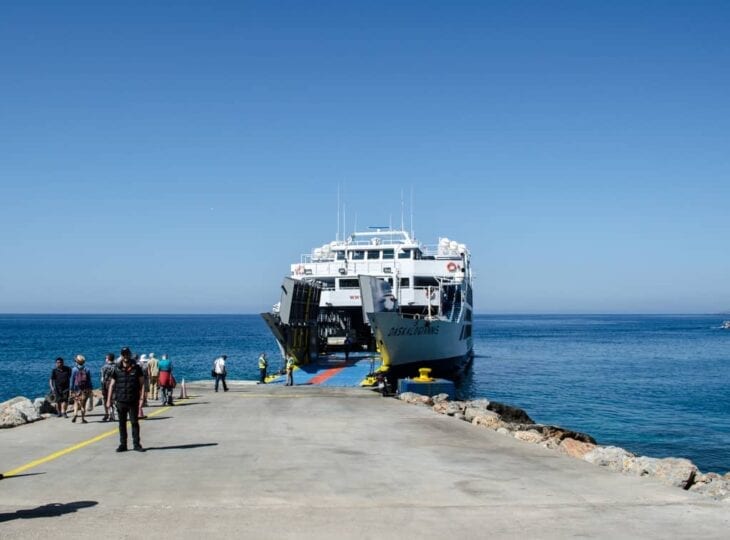
Where is Loutro located?
Loutro is a small, remote seaside village in southern Crete, located 96 kilometres from Chania. Loutro is about a 2-hours drive away from the main town of Chania. Loutro lies in west Crete between Chora Sfakion and Agia Roumeli, which is the exit to the Samaria Gorge. The whole territory is known as Sfakia.
What is the geography of Loutro?
The majestic scenery of Loutro Crete is known as an asleep fishing village on the southern coast of the Chania Region, featuring its well-known whitewashed villages of Greece. Loutro village is a rocky islet in the Gulf of Loutro on the southwest coast of Crete in the Libyan Sea. The islet is found close to the end of the Mouri cape, which is administratively part of the municipality of Sfakia. The coastal village of Loutro is approximately 71 kilometres south of Chania. The climate in Loutro throughout the year is predictable. The dry season in Loutro is during the months of May, June, July and August. The warmest season is in August, which has an average maximum temperature of 32° Celsius. The month of January is the coldest month, with an average maximum temperature of 15° Celsius. Additionally, January tops as the wettest month with 98 mm of rainfall. The months of May, October and November are most likely to experience good weather with pleasant average temperatures that fall between 20° Celsius and 26° Celsius.
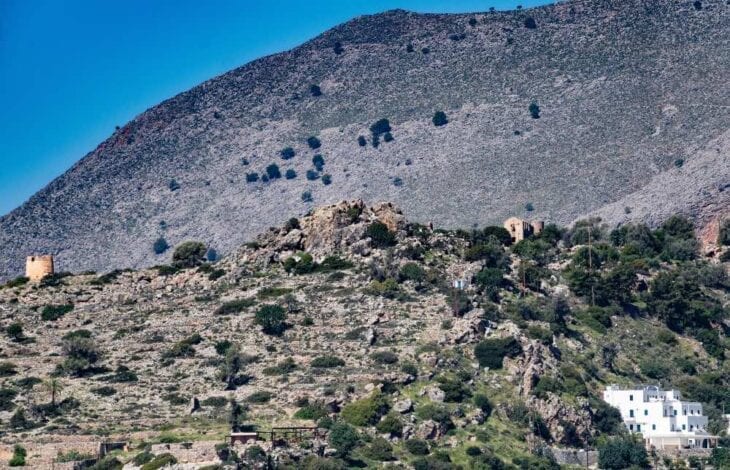
How does the Loutro Map look?
Tourists remember Loutro Crete because of the dramatic scenery and the iconic whitewashed village. Accompanying secluded hidden beaches and rocky landscapes with majestic views from the seaside. The map of Loutro Crete gives a glimpse of the route and one understands why it should be part of a bucket list when visiting the island of Crete.
Below is the image map of Loutro Crete.
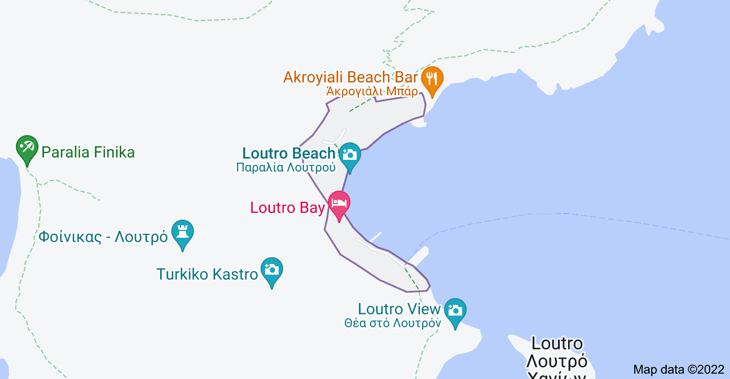
How was daily living in Loutro?
Loutro is an odd fishing village on the southern coast of Crete. Living in Loutro is peaceful and quiet, which is ideal for those who seek to distress, reconnect and reset. Loutro exudes an unmatched tranquillity and authenticity that permeates every corner of the tiny settlement. Generally, the locals living in South Crete have a humble lifestyle. Cretan villages continuously serve dishes that have been for generations, such as dakos salad, a bare rusked salad topped with sun-ripened tomatoes, feta cheese and olive oil. Crime rates in Loutro Crete are typically low, just like in any other part of Greece.
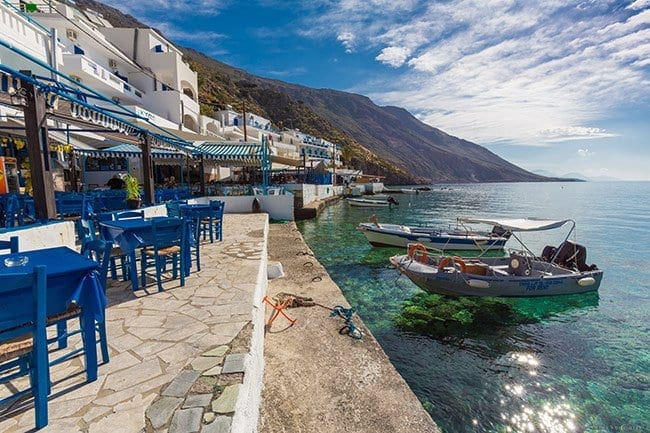
What are the activities to do in Loutro?
The main reason to spend time in Loutro Crete is to unwind and slow down. However, even though Loutro is considered to have a peaceful mood, there are three main interesting activities to do in Loutro Crete, such as Rent a Boat, Walking in the Village area and visit the tourists attractions.
Listed below are the activities to do in Loutro.
- Rent a Boat: Renting a boat is a better way to appreciate the pristine sea of Loutro. Rental daily fees depend on the boat to choose. However, the prices start at €80 per day. It is important to remember that the fee is usually necessary to add up the price of petrol. The magnificent sea in the gulf of Loutro is one of the things that have made the village famous. As a matter of fact, Loutro is quite well-known for the stunning colour of the sea, a magnificent palette ranging from light turquoise to deep navy blue.
- Walking in the Village area: Walking in the village is ideal to venture further into the Loutro Crete. The small village of Loutro is quite east to explore on foot. One of the main features of Loutro is its shape, which is built in such a compact way that keeps everything connected.
- Visit the tourist attractions: Visit the tourist attractions are the best things to do in Loutro. Take time to discover the popular places to visit in Loutro and the typical landscape of South Crete. Enjoy walking through the scenic and pristine mountain countryside style valleys and gorges.

How do you get to Loutro?
In order to reach Loutro, the first thing to do is by getting into Chora Sfakion. There are three ways to reach Chora Sfakion: by car, bus and by boat. The most convenient way to reach Chora Sfakion is by renting a car for the tourists. Driving in Crete is a one-of-kind experience, it is a better way to explore the island. Whether the tourists are coming from Chania or from the East (Rethymno, Heraklion or Agios Nikolaos). To get from the north coast of Crete to Chora Sfakion, tourists need to reach the village of Vryses and drive south through the green landscape of Askifou plateau. The road continues passing the gorge of Imbros and then descends towards the sea, leaving tourists right in Chora Sfakion. The whole trip from Vrysses to Chora Sfakion takes about 45 minutes. From Chora Sfakion, there are two ways to reach Loutro Crete, it is by foot or by boat. The most convenient way would be by riding a boat. The boat ride costs about €6 and takes about 20 minutes to reach Loutro Crete.
How do you get to Loutro from Chania?
Listed below is how to get to Loutro from Chania,
- Step 1: Traveling from Chania to Loutro, 93.6 kilometers (58.16 miles), begins with the traveler deciding on their preferred mode of transportation. Options include renting a car, hailing a taxi, or boarding a bus from the Chania Central Bus Station. Car rentals and taxis offer a more flexible and faster journey, taking 2 hours and 15 minutes. While more economical, the bus will take 3 hours due to multiple stops.
- Step 2: The route leads southeast along the E75 highway from Chania. This stretch of the journey covers a distance of 60 kilometers (37.28 miles) and takes travelers through the Cretan countryside. This leg of the trip will take 1 hour and 15 minutes by car or taxi, while the bus journey may take slightly longer due to potential stops en route.
- Step 3: Upon reaching the town of Vrises, 60 kilometers (37.28 miles) from Chania, travelers will need to make a left turn onto a smaller, winding road that leads to the coastal village of Chora Sfakion. This turn is crucial for those traveling by car or taxi. On the other hand, bus passengers may need to change buses to continue their journey.
- Step 4: The road from Vrises to Chora Sfakion stretches for 33 kilometers (20.51 miles) and offers vistas of the Libyan Sea. Navigating this narrow, mountainous road by car or taxi will take 45 minutes, while the bus journey may take longer. Travelers should enjoy the scenic views and prepare for the next leg of their trip.
- Step 5: Arriving in Chora Sfakion, travelers will find themselves in a delightful coastal village. To reach Loutro from this point, one must embark on a boat journey, as no roads connect the two villages. Travelers can purchase boat tickets at the port, and the boat ride itself takes 20 minutes.
- Step 6: The boat ride from Chora Sfakion to Loutro is an experience. The vessel navigates along the rugged coastline of the Sfakia region. During the journey, passengers can take in the views of the crystal-clear, turquoise waters and the white-washed houses of Loutro as they approach the village.
Can you walk to Loutro?
Yes, a walk to Loutro from Chora Sfakion is possible, but it is a challenging hike not recommended for everyone, especially those carrying luggage or elderly individuals. The hike follows the E4 European long-distance path, which runs along the rugged coastline of the Sfakia region. The trail is 7 kilometers (4.35 miles) long and can take 2 to 3 hours, depending on the hiker’s fitness level and the weather conditions. The path is rocky and uneven, with several steep ascents and descents. It is essential to note that the hike can be strenuous, especially during the hot summer months, and there is limited shade and no water sources along the route. Hikers should wear sturdy shoes, bring plenty of water, and protect themselves from the sun. The trail can be challenging to navigate in some sections, so it is advisable to have a map or a GPS device. The most convenient and practical option is taking the boat from Chora Sfakion to Loutro.
What are the ferry options to Loutro?
Listed below are the ferry options to Loutro.
- Private boat taxi: Private boat taxis offer a flexible and convenient way to reach Loutro from Chora Sfakion. These small boats can accommodate up to 8-10 passengers and can be hired for a direct journey to Loutro. The distance from Chora Sfakion to Loutro is 7 kilometers (4.35 miles) by sea, and the journey takes 20 minutes. The cost of a private boat taxi varies depending on the season and the number of passengers, but it typically ranges from €60 ($65.4, £52.2).
- Ferry (Anendyk): Anendyk is a popular ferry company that operates regular services from Chora Sfakion to Loutro. The ferry covers the 7 kilometers (4.35 miles) between the two villages in about 20 minutes. During the high season (May to October), the ferry runs several times a day, while in the low season, the frequency may be reduced. A one-way ticket from Chora Sfakion to Loutro costs €8.7 ($9.5, £7.6) per person.
- Water taxi: Small boats provide a shared transportation option from Chora Sfakion to Loutro. These boats typically carry up to 20 passengers and cover the 7-kilometer (4.35 miles) distance in 20 minutes. Water taxis are more affordable than private boat taxis, ranging from €11 ($12, £9.4) to €16 ($17.4, £13.7) per person for a one-way trip.
- Ferry (Sfakia Cruises): Sfakia Cruises is another ferry company that offers services from Chora Sfakion to Loutro. Their boats cover the 7-kilometer (4.35 miles) distance in 20 minutes and operate several times daily during the high season. A one-way ticket from Chora Sfakion to Loutro with Sfakia Cruises costs €8.7 ($9.5, £7.6) per person.
- Ferry (Loutro Cruises): Loutro Cruises is a local ferry company specializing in trips to Loutro and other nearby coastal villages. They operate modern boats that accommodate up to 50 passengers and cover the 7-kilometer (4.35 miles) distance from Chora Sfakion to Loutro in 20 minutes. The company offers several daily departures during the peak season, and the frequency may be reduced in the low season. A one-way ticket from Chora Sfakion to Loutro with Loutro Cruises costs €8.7 ($9.5, £7.6) per person.
Are cars allowed in Loutro?
No, cars are not allowed in Loutro. Loutro is a small seaside village on the south coast of Crete that can only be accessed by boat or on foot, as no roads lead to the village. The lack of cars and roads gives Loutro a peaceful atmosphere, allowing visitors to disconnect from the noise of everyday life in the city. All goods and supplies must be transported by boat and then carried through the village on wheelbarrows or by hand. This car-free environment preserves the village’s authentic ambience and traditional architecture, with its whitewashed houses and narrow alleys. The absence of vehicles means visitors can enjoy the area’s natural beauty without the noise and pollution associated with traffic.
What are the factors to consider before renting a car in Crete?
Listed below are the factors to consider before renting a car in Crete.
- Insurance: Car rental insurance protects a passenger against the cost of damage when renting a car. Crete car rental includes insurance for collision damage waiver and a driver’s credit card is required as a guarantee.
- Driver’s age: The legal age requirement to drive in Crete is 18 years old. One must have a valid driving licence.
- Driver’s gender: Both women and men are allowed to drive in Crete. As long as the driver is of the legal age 18, driving is allowed in Crete, regardless of gender.
- Car type: One must learn how to choose the right car to rent in Crete. Travelling with groups or family members requires a much bigger car. Car rental companies in Crete offer a variety of cars to pick from. Selecting a smaller car is best when driving in Crete. The reason for that is that some Greek roads are narrow. The car type is one big factor in how to choose the right car to rent in Crete.
- Documents needed for renting a car: One important document needed for renting a car is a valid driving licence. However, a credit or debit card are being presented, including a passport or an ID card.
How much does a car rental in Crete cost?
Loutro Crete is an enchanting island with tourist spots that travel using a rented vehicle. Crete car rental costs vary depending on the number of persons, itinerary, car type, destination and duration. The average cost of renting a car in Crete is around €30 to €40 per day. A car rented for a whole week will cost an average of €250. Renting a vehicle for the weekend will cost around €78. Crete car rental rates differ depending on the car type. Car rental companies offer a variety of cars depending on customers’ liking. Most car rental companies in Crete offer an online booking system, whenever customers want to book a car. Simply follow the process and instantly book a vehicle on their website. Before renting a car in Crete, make sure to check all the requirements needed.
Where to park when going to Loutro?
There are several parking spots to park your car when going to Loutro. Firstly, the parking lot in Hora Sfakion 730 11, Greece, in the town of Hora Sfakion (called Chora Sfakion or Sfakia), the main town near Loutro, provides convenient access to the port, where travellers can catch the ferry or boat to Loutro. Secondly, Easy Parking-Chora Sfakion at one χιλιόμετρο επαρχιακής οδού, Βρύσες 730 11, Greece, is a designated parking area 1-kilometre (0.62-mile) away from the town centre of Hora Sfakion. This parking spot offers more availability and space. Thirdly, the parking lot in Sfakia 730 11, Greece, is another central parking lot in Hora Sfakion (Sfakia), providing easy access to the port for taking the ferry/boat to Loutro. Fourthly, the Port of Sfakia at Hora Sfakia 730 11, Greece, is the closest and most convenient option for transportation to Loutro. Parking may be limited right at the port. Lastly, Platia Sfakia at Chora Sfakion 1, Chora Sfakion 730 11, Greece, is a parking area in the main square or plaza (Platia) of Chora Sfakion. Parking in the town square offers more availability than the limited spaces in the port area.
How much does it cost to get to Loutro?
Enjoy the Loutro Crete with affordable costs while having an amazing view of the whitewashed villages. The food in Loutro Crete is affordable yet delicious. Food costs about €20 which is good for two people. In terms of transportation, from Chora Sfakion there are two ways to reach Loutro Crete, it is by foot or by boat. Boats from the port of Chora Sfakion have daily departures from May to October. The boat ticket costs about €6 and takes about 20 minutes to reach Loutro Crete.
Where to stay near Loutro?
Accommodation in Loutro Crete is limited, because of being such a small village. There are few hotels and rooms to rent. The hotels near Loutro are, Porto Loutro, Daskalogiannis and Sofia Rooms. Having limited accommodation is the way how the Loutro Crete manages to retain its unspoiled charm. It is recommended to book a place to stay in advance. Finding a place to stay is much easier for those tourists visiting in May, June and even late September. Remember that there are no hotels with swimming pools and such amenities in Loutro Crete.
What are the nearby attractions in Loutro?
Listed below are the nearby attractions in Loutro.
- Balos Beach: Balos beach and lagoon is one of the most beautiful beaches located 51 kilometres away from Chania. Tourists choose to ride between a car or ferry to reach Balos beach. Balos beach is a popular nearby attraction in Loutro. It is a sandy beach with turquoise, crystalline water. The beach becomes overcrowded during the season of summer. It is ideal to visit the beach during the 4th week of October to experience a quiet and relaxing place if tourists want to avoid Balos Beach being too crowded.
- Elafonissi Beach: Elafonissi Beach is found on the southeast side of Crete, 75 kilometres away from Chania. Travellers won’t have a hard time entering the area of Elafonissi, as it has a paved road with good parking lots. The beach has parasols, sun beds, beach bars and toilets around the area. Elafonissi has a crystal clear sandy beach and is soft. The best time for a tourist to visit the Elafonissi beach is around September and October, for autumn is an ideal time to swim. The water during that time is warm and calm. Wearing masks and social distancing on the beach is now lifted and no longer mandatory by the government of Greece.
- Seitan Limania: Seitan Limania Beach is 20 kilometres away from the southeast side of Chania and is mesmerising and has a unique landscape that connects the beach to the deep sea. Unlike the Balos Beach, tourists reach Seitan Limania Beach by car comfortably. However, Seitan Limania Beach does not have any facilities, tourists need to bring everything to the beach.
- Matala Beach: Matala Beach is a popular destination on the southern coast of Crete, It is found in the region of Heraklion. Matala Beach is a place that shelters a unique hippie atmosphere and even just one day spent in Matala is enough to feel its vibe and connect with the Bohemian side of Crete.
- Vai Beach: Vai Beach is situated in the region of Lasithi. It is one of the most beautiful and exotic beaches in Crete and offers a fantastic place to discover. Furthermore, Vai beach is located in the heart of a protected natural palm tree forest, which is known as Finikodasos.
What are the best things to do in Loutro?
The southwestern coast of Crete is home to several beaches and historical sites that offer visitors a unique blend of natural beauty and cultural heritage. This region of Crete is a true gem for those seeking adventure, relaxation and a view into the island’s rich history, highlighting the secluded Glyka Nera Beach with its freshwater springs, towering cliffs to the remote Marmara Beach at the end of the Aradena Gorge and the 19th-century Koules of Loutro fort overlooking the village of Loutro.
Listed below are the best things to do in Loutro:
- Glyka Nera Beach: Glyka Nera Beach is a secluded beach between Chora Sfakion and Loutro on the southwestern coast of Crete. It is a small 300-metre-long (0.18-mile) beach with clear turquoise waters and colourful pebbles, surrounded by towering 500-metre-high (1,640-feet) cliffs. The beach has freshwater springs flowing into the sea, giving the water a slightly sweet taste and cooler temperature. Visitors can enjoy swimming, snorkelling, sunbathing, hiking along coastal trails and relaxing at the small tavern.
- Marmara Beach: Marmara Beach is a remote and secluded pebbly bay at the end of the Aradena Gorge in the Sfakia region of Crete, surrounded by towering cliffs and colourful soft rocks. The beach has clear turquoise waters that are perfect for swimming and snorkelling. The beach has marble caves and rock formations along the shore, which visitors can explore by swimming through and discovering interconnected passages. The beach offers opportunities for sunbathing, hiking along coastal trails or the Aradena Gorge and enjoying fresh local cuisine at the small taverna above the beach.
- Koules of Loutro: The Koules of Loutro is a 19th-century rectangular Turkish fort built on a hill above the port of Loutro in the Sfakia region of Crete. It is a protected Ottoman architectural monument with two elevated tower positions on the east and west sides. Some of its walls still stand, providing a view into its former defensive purpose against Cretan revolts against Turkish occupation.
- Frangokastello Fortress: Frangokastello Fortress is a historical monument from the 14th-century Venetian era. This rectangular fortress features four corner towers and a central courtyard with 8-meter-high walls.
- Aradena Gorge: Aradena Gorge is located in near Sfakia Crete and offers a rugged natural spectacle. The 7 7-kilometer (4.35 miles) gorge, formed by the Aradena River, features cliffs and narrow passages, demanding visitors a 3-4 hour hike.
1. Glyka Nera Beach
Glyka Nera Beach or Sweet Water Beach, is a beautiful and secluded beach on the southwestern coast of Crete, Greece. Glyka Nera Beach is between Chora Sfakion and Loutro, 4 kilometres (2.4 miles) west of Chora Sfakion and 75 kilometres (46 miles) south of Chania. It is a small beach, 300 metres long (0.18 miles), with clear turquoise waters and fine, colourful pebbles. The beach is surrounded by towering cliffs that rise to 500 metres (1,640 feet) above sea level. One of the unique features of Glyka Nera Beach is the presence of freshwater springs that flow into the sea, giving the water a slightly sweet taste and a cooler temperature, even during the hot summer months. The beach is best for families, couples and adventure seekers, offering a unique and peaceful experience.
Visitors can enjoy various activities at Glyka Nera Beach. The beach offers opportunities for swimming, sunbathing and relaxing on the fine pebbles or renting sunbeds and umbrellas. The clear turquoise waters are ideal for snorkelling and exploring the underwater world. Visitors can also hike along the coastal trails that lead to the beach, taking in the views of the cliffs and the Libyan Sea. A small tavern at the beach offers food, drinks and camps overnight under the tamarisk trees. The eastern part of the beach is popular among naturists. Visitors can take a boat from Chora Sfakion or Loutro or hike along the E4 European hiking trail, which takes 30 minutes from Chora Sfakion and 60 minutes from Loutro to reach Glyka Nera Beach. There is no admission cost to access the beach.
2. Marmara Beach
Marmara Beach is a secluded beach at the end of the Aradena Gorge in the Sfakia region of Crete. Marmara Beach is 85 kilometres (52 miles) south of Chania and 5 kilometres (3.1 miles) west of the village of Loutro. The beach’s remote location and lack of road access add to its ambience, making it a true hidden gem. It is a small, pebbly bay surrounded by towering cliffs and soft, colourful rocks, giving the area its unique beauty. The beach is known for its clear turquoise waters, perfect for swimming and snorkelling and the marble caves and rock formations that line the shore. Visitors can explore these caves by swimming through them and discovering small passages that connect different caves. Marmara is best for adventure seekers, nature lovers and those seeking a peaceful escape from the city.
Visitors can enjoy various activities at Marmara Beach. The beach offers opportunities for swimming, sunbathing and relaxing on the pebbles or renting sunbeds and umbrellas. The beach provides a starting point for hiking along the coastal trails or the nearby Aradena Gorge. Visitors can enjoy the beautiful scenery of the cliffs, rock formations and waters. There is a small taverna above the beach where visitors can enjoy fresh local cuisine, refreshments and live music in the evenings, making it a perfect holiday destination. Visitors can reach Marmara Beach by hiking the Aradena Gorge, which takes 4 hours or by boat from Loutro or Chora Sfakion during the summer months. There is no admission cost to access the beach. Visitors must pay for boat transportation or rent umbrellas and sunbeds if desired.
3. Koules of Loutro
The Koules of Loutro is a 19th-century Turkish fort on a hill above the port of Loutro, in the municipality of Sfakia, Chania regional unit, on the southern coast of Crete. It is an example of Ottoman architecture and one of the few Cretan fortresses built by the Turks that has been designated as a protected monument. The fort is rectangular and features two elevated tower positions on the east and west sides. Some of its walls still stand today, providing a view into its former defensive purpose. There is a cistern that supplied water to the fort and remnants of a windmill can still be seen nearby, highlighting the self-sufficiency of this fortification. The fort was built in 1868 by the Ottomans after the Cretan Revolution of 1866, serving as the central fort in the area to control the frequent revolts of the Cretan people against Turkish occupation.
Visitors to the Koules of Loutro can explore the ruins of this 19th-century Turkish fort, wander through the remaining walls and foundations and admire the strategic location that once allowed the fort to overlook and control the port below. Visitors can take in the g views from the fort ruins, with vistas of the village of Loutro, the surrounding mountains and the blue waters of the Libyan Sea. Walking around the archaeological site provides an opportunity to learn about the region’s history while enjoying the beautiful natural scenery that makes Loutro a must-visit destination. Visitors can access the village only by boat or on foot, as no roads lead to it and visitors can hike from the port area. There is no admission cost to visit the Koules of Loutro, as it is an open-air archaeological site.
4. Frangokastello Fortress
The Frangokastello Fortress is a historical monument that was constructed in the 14th century during the Venetian rule of Crete. The fortress has a rectangular structure with four corner towers and a central courtyard. The walls are made of stone and measure 8 meters (26.25 feet) in height and 2 meters (6.56 feet) in thickness. The Venetian Fortress is located on the southern coast of Crete, 12 kilometers (7.46 miles) east of the village of Chora Sfakion and 80 kilometers (49.71 miles) southwest of Rethymno. It is located directly on the beach of Frangokastello, overlooking the Libyan Sea. Visiting the Venetian Fortress is free, with no entrance fees or costs. During daylight hours, visitors can explore the exterior and interior of the fortress, including the courtyard and towers, at their leisure. The distance from Loutro to the Venetian Fortress is 15 kilometers (9.32 miles). Loutro is a small fishing village located west of Frangokastello, accessible only by boat or on foot. To reach the fortress from Loutro, visitors must first travel to Chora Sfakion by boat, then drive or take a bus east to Frangokastello.
5. Aradena Gorge
Aradena Gorge is a gorge located in the region of Sfakia, Crete, Greece. It is formed by the Aradena River, which flows through the gorge and empties into the Libyan Sea. The gorge is known for its cliffs, narrow passages, and rugged terrain. It measures 7 kilometers (4.35 miles) in length and reaches depths of up to 200 meters (656.17 feet). Aradena Gorge is located in the southwestern part of Crete, near the village of Aradena. It is located 5 kilometers (3.11 miles) east of the village of Loutro and 20 kilometers (12.43 miles) south of Chora Sfakion. The gorge is part of the broader network of gorges in the Sfakia region, which includes the famous Samaria Gorge. Visiting Aradena Gorge is free of charge, with no entrance fees or access costs. Visitors must be prepared for a challenging hike through the gorge, which requires good physical fitness and appropriate hiking gear. The hike through the gorge typically takes 3-4 hours to complete. The distance from Loutro to the starting point of the Aradena Gorge hike is 5 kilometers (3.11 miles). Visitors can reach the trailhead by hiking east from Loutro along the coastal path, which takes 1-2 hours.
What are the best beaches to swim near Loutro?
The southwestern coast of Crete is home to some of the most beautiful beaches in Greece, offering visitors a blend of natural beauty and adventure. Glyka Nera Beach and Marmara Beach are considered the best beaches for swimming near the village of Loutro. These beaches, accessible only by boat or hiking trails, are must-visit destinations for visitors seeking a peaceful and unforgettable beach experience in Loutro.
Listed below are the best beaches to swim near Loutro:
- Loutro Beach: Loutro Beach is located directly in Loutro village. It is a small pebble Beach, easily accessible that offers clear blue waters for swimming. It is also near tavernas and cafes, providing convenience despite lacking organized facilities.
- Glyka Nera Beach: Glyka Nera Beach is a beautiful and secluded beach on the southwestern coast of Crete, Greece. One of the beach’s unique features is the presence of freshwater springs that flow into the sea, giving the water a slightly sweet taste and a cooler temperature, even during the hot summer months. Glyka Nera Beach offers amenities for visitors, including a small tavern serving food and drinks and renting out umbrellas and sunbeds.
- Marmara Beach: Marmara Beach is a secluded beach at the end of the Aradena Gorge in the Sfakia region of Crete. The beach is known for its clear turquoise waters, perfect for swimming and snorkelling and the marble caves and rock formations that line the shore. Visitors can explore these caves by swimming through them and discovering small passages that connect different caves. There is a small taverna above the beach where visitors can enjoy fresh local cuisine, refreshments and live music in the evenings, making it a perfect holiday destination.
- Finikas Beach: Finikas Beach is a small, sandy beach located 3 kilometers (1.86 miles) west of Loutro village. It is in a sheltered cove surrounded by rocky cliffs and hills covered in pine trees.
- Lykos Beach: Lykos Beach is located 4 kilometers (2.49 miles) east of Loutro village. It stretches for 1 kilometer (0.62 miles) along the southern coast of Crete.. Lykos Beach is, along the southern coast of Crete. Visitors must arrange their transportation to the beach by hiring a boat from Loutro or hiking the coastal trail. The beach needs to have organized facilities, such as sunbeds or umbrellas; visitors must bring their supplies and equipment.
1. Loutro Beach
Loutro Beach is located in the village of Loutro, Crete, Greece. It is a small pebble beach stretching 200 meters (656.2 feet) along the eastern side of the village’s harbor. The Libyan Sea borders the beach to the south and the village’s waterfront promenade to the north. Loutro Beach is in the center of Loutro village, located on the southern coast of Crete, 70 kilometers (43.5 miles) south of Chania and 20 kilometers (12.43 miles) west of Chora Sfakion. The beach is accessible from anywhere in the village, parallel to the main waterfront road. Visiting Loutro Beach is free of charge, with no entrance fees or costs for access. Visitors can freely use the beach for swimming, sunbathing, and other recreational activities. The beach has no organized facilities, such as sunbeds or umbrellas, but several tavernas and cafes along the waterfront offer refreshments and shade. The distance from the center of Loutro village to Loutro Beach is 0.1 kilometers (0.06 miles). Visitors can reach the beach on foot by walking along the village’s waterfront promenade, which takes 1-2 minutes. The beach is visible from most points in the village and is easily recognizable by its characteristic pebble shore and clear blue waters
2. Glyka Nera (Sweetwater Beach)
Glyka Nera, also known as Sweetwater Beach, is a secluded pebble near Loutro, Crete, Greece. It is located at the base of a cliff face, surrounded by towering rocks and lush vegetation. The beach is named after the freshwater springs that flow from the cliffs and mix with the seawater, creating a unique swimming experience. Glyka Nera is located 1.24 miles (2 kilometers) west of Loutro village, along the southern coast of Crete. It is located within the boundaries of the Samaria Gorge National Park and is only accessible by boat or on foot via a hiking trail from Loutro. Visiting Glyka Nera is free, with no entrance fees or access costs. Visitors must arrange their transportation to the beach by hiring a boat from Loutro or hiking the coastal trail. The beach does not have organized facilities, such as sunbeds or umbrellas; visitors must bring their supplies and equipment. The distance from Loutro village to Glyka Nera is 1.24 miles (2 kilometers). Visitors can reach the beach by hiking along the coastal trail west of Loutro, which takes 30-45 minutes, depending on the pace. They can hire a boat from Loutro harbor, which takes 10-15 minutes to reach the beach.
3. Marmara Beach
Marmara Beach is located near the village of Loutro, Crete, Greece. It is a small, pebble beach in a cove surrounded by rocky cliffs and hills covered in olive groves. The beach is known for its crystal-clear waters and atmosphere, making it a popular spot for swimming and snorkeling. Marmara Beach is 1.5 kilometers (0.93 miles) east of Loutro village, along the southern coast of Crete. It is located between the beaches of Loutro and Glyka Nera and is accessible by boat or on foot via a hiking trail from Loutro. Visiting Marmara Beach is free of charge, with no entrance fees or access costs. Visitors must arrange their transportation to the beach by hiring a boat from Loutro or hiking the coastal trail. The beach must have organized facilities, such as sunbeds or umbrellas, and visitors must bring supplies and equipment. The distance from Loutro village to Marmara Beach is 1.5 kilometers (0.93 miles). Visitors can reach the beach by hiking along the coastal trail that leads east from Loutro, which takes 20-30 minutes, depending on the pace. They can hire a boat from Loutro harbor, which takes 5-10 minutes to reach the beach. The boat ride offers scenic views of the coastline and the surrounding cliffs, making it a convenient and enjoyable option for visitors.
4. Finikas Beach
Finikas Beach is a small, sandy beach near Loutro, Crete, Greece. It is in a sheltered cove surrounded by rocky cliffs and hills covered in pine trees. The beach is known for its calm, shallow waters and secluded location, making it a popular spot for families with children and those seeking a quiet, relaxing atmosphere. Finikas Beach is located 3 kilometers (1.86 miles) west of Loutro village, along the southern coast of Crete. It is located within the boundaries of the Samaria Gorge National Park and is only accessible by boat or on foot via a hiking trail from Loutro. Visiting Finikas Beach is free of charge, with no entrance fees or costs for access. The beach must have organized facilities, such as sunbeds or umbrellas, and visitors must bring their supplies and equipment. The distance from Loutro village to Finikas Beach is 3 kilometers (1.86 miles). Visitors can reach the beach by hiking along the coastal trail west of Loutro, which takes 1 hour, depending on the pace. The boat ride offers breathtaking views of the rugged coastline and the turquoise waters of the Libyan Sea, making it a scenic and enjoyable option for visitors
5. Lykos Beach
Lykos Beach is located near the village of Loutro, Crete, Greece. It is a long, narrow beach that stretches for 1 kilometer (0.62 miles) along the southern coast of Crete. The beach is composed of sand and pebbles and is backed by cliffs and hills covered in scrub vegetation. The waters at Lykos Beach are deep and clear, making it a popular spot for swimming and snorkeling. Lykos Beach is located 4 kilometers (2.49 miles) east of Loutro village, along the southern coast of Crete. It is located between the beaches of Marmara and Glyka Nera and is only accessible by boat or on foot via a hiking trail from Loutro. Visiting Lykos Beach is free of charge, with no entrance fees or costs for access. Visitors must arrange their transportation to the beach by hiring a boat from Loutro or hiking the coastal trail. The beach needs to have organized facilities, such as sunbeds or umbrellas; visitors must bring their supplies and equipment. The distance from Loutro village to Lykos Beach is 4 kilometers (2.49 miles). Visitors can reach the beach by hiking along the coastal trail that leads east from Loutro, which takes 1 hour and 15 minutes, depending on the pace. The boat ride offers views of the rugged coastline and the Libyan Sea’s deep blue waters, making it a convenient option for visitors.
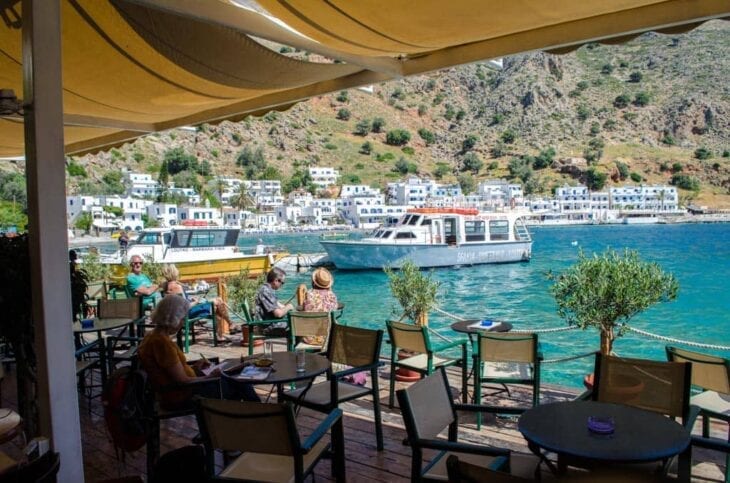
Is Loutro safe?
Yes, Loutro Crete is safe. Crime rates in Loutro are typically low, just like in any other part of Greece. Since there are many police officers on the island, assistance is never far away should an accident occur. Like other Mediterranean islands that have been visited by tourists, Loutro is thought to be a secure tourist destination. The locals in Loutro are welcoming and friendly, anyone is allowed to freely explore the village and feel quite secure and relaxed. However, keeping an eye on one’s belongings and avoiding walking late at night alone are just a few of the sensible things to consider when travelling.
Is Loutro worth visiting?
Yes, Loutro Crete is worth visiting. Absolutely, Loutro Crete is worth visiting and recommended by tourists. Tourists love the magnificent view from the sea, the crystal-clear water, peaceful vibe, secluded beaches, easy hikes and ancient ruins. However, Loutro is not for people who want a nightlife.








